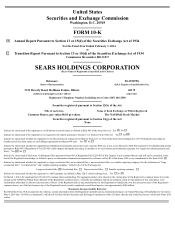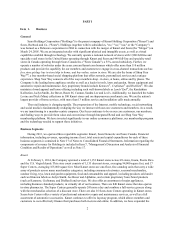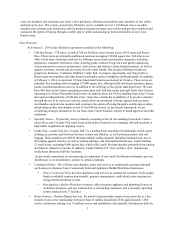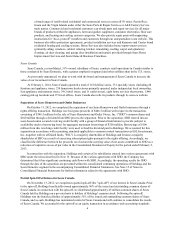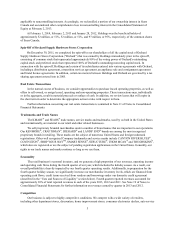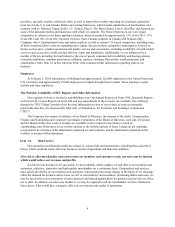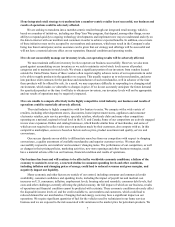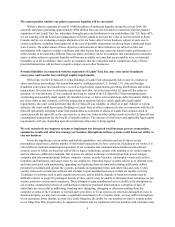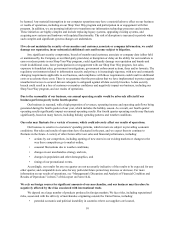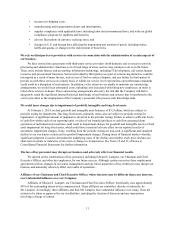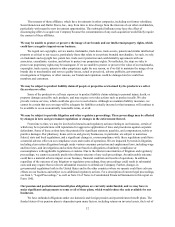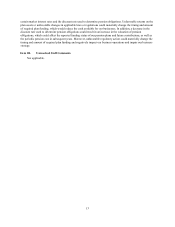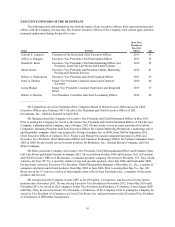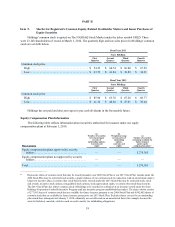Sears 2013 Annual Report Download - page 8
Download and view the complete annual report
Please find page 8 of the 2013 Sears annual report below. You can navigate through the pages in the report by either clicking on the pages listed below, or by using the keyword search tool below to find specific information within the annual report.8
could experience a disruption in energy supplies, including our supply of gasoline, as a result of factors that are
beyond our control, which could have an adverse effect on our business. Certain of our vendors also could
experience increases in the cost of various raw materials, such as cotton, oil-related materials, steel and rubber,
which could result in increases in the prices that we pay for merchandise, particularly apparel, appliances and tires.
The domestic and international political situation also affects consumer confidence. The threat, outbreak or
escalation of terrorism, military conflicts or other hostilities could lead to a decrease in consumer spending. Any of
these events and factors could cause us to increase inventory markdowns and promotional expenses, thereby
reducing our gross margins and operating results.
The lack of willingness of our vendors to provide acceptable payment terms could negatively impact our
liquidity and/or reduce the availability of products or services we seek to procure.
We depend on our vendors to provide us with financing on our purchases of inventory and services. Our
vendors could seek to limit the availability of vendor credit to us or other terms under which they sell to us, or both,
which could negatively impact our liquidity. In addition, the inability of vendors to access liquidity, or the
insolvency of vendors, could lead to their failure to deliver inventory or other services. Certain of our vendors
finance their operations and/or reduce the risk associated with collecting accounts receivable from us by selling or
“factoring” the receivables or by purchasing credit insurance or other forms of protection from loss associated with
our credit risks. The ability of our vendors to do so is subject to the perceived credit quality of the Company. Such
vendors could be limited in their ability to factor receivables or obtain credit protection in the future because of our
perceived financial position and creditworthiness, which could reduce the availability of products or services we
seek to procure.
Certain factors, including changes in market conditions and our credit ratings, may limit our access to capital
markets and other financing sources and materially increase our borrowing costs.
In addition to credit terms from vendors, our liquidity needs are funded by our operating cash flows and, to the
extent necessary, borrowings under our credit agreements and commercial paper program and access to capital
markets. The availability of financing depends on numerous factors, including economic and market conditions, our
operating performance, our credit ratings, and lenders' assessments of our prospects and the prospects of the retail
industry in general. Changes in these factors may affect our cost of financing, liquidity and our ability to access
financing sources, including our commercial paper program and possible second lien indebtedness that is permitted
under the domestic revolving credit facility, with respect to each of which we have no lender commitments. Rating
agencies revise their ratings for the companies that they follow from time to time and our ratings may be revised or
withdrawn in their entirety at any time.
While the Company's domestic revolving credit facility currently provides for up to $3.275 billion of lender
commitments, our ability to borrow funds under this facility is limited by a borrowing base determined relative to
the value, from time to time, of eligible inventory, accounts receivable and certain other assets. In addition, our
ability to incur possible second lien indebtedness that is otherwise permitted under the domestic revolving credit
facility is limited by a borrowing base requirement under the indenture that governs our senior secured notes due
2018. If, through asset sales or other means, the value of these eligible assets is not sufficient to support borrowings
of up to the full amount of the commitments under this facility, we will not have full access to the facility, but rather
could have access to a lesser amount determined by the borrowing base. Such a decline in the value of eligible
assets also could result in our inability to borrow up to the full amount of second lien indebtedness permitted by the
domestic credit facility, but rather we could be limited to borrowing a lesser amount determined by the borrowing
base as calculated pursuant to the terms of the indenture. The domestic revolving credit facility also effectively
limits full access to the facility if our fixed charge ratio at the last day of any quarter is less than 1.0 to 1.0. As of
February 1, 2014, our fixed charge ratio was less than 1.0 to 1.0.
The lenders under our credit facilities may not be able to meet their commitments if they experience shortages
of capital and liquidity and there can be no assurance that our ability to otherwise access the credit markets will not
be adversely affected by changes in the financial markets and the global economy.

